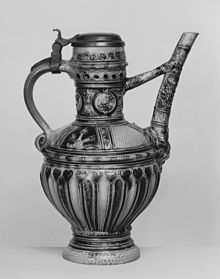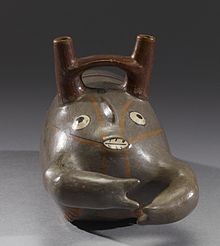

A bridge-spouted vessel is a particular design of ewer (jug or pitcher) originating in antiquity; there is typically a connecting element between the spout and filling aperture, and the spout is a completely independent aperture from the usually smaller central fill opening. Early examples of the bridge-spouted vessel are found in ancient Persia in the early Iron Age and on Crete. This type of vessel typically appears in the Bronze Age or early Iron Age. A very early example of a bridge-spouted vessel in Minoan pottery has been recovered at the ancient palace of Phaistos on Minoan Crete, dating to the Bronze Age.
There is a different type, called a double spout and bridge vessel, characteristic of the pottery of the Nazca culture of Pre-Columbian Peru, where two spouts rising vertically from the body of the vessel are linked by a bridge that apparently also served as a carrying handle.
See also
References
- British Museum "Bridge spout" on collection database
- "C. Michael Hogan, Phaistos Fieldnotes, The Modern Antiquarian (2007)". Archived from the original on 2017-09-08. Retrieved 2009-01-26.
This article about an item of drinkware or tool used in preparation or serving of drink is a stub. You can help Misplaced Pages by expanding it. |
This ceramic art and design-related article is a stub. You can help Misplaced Pages by expanding it. |